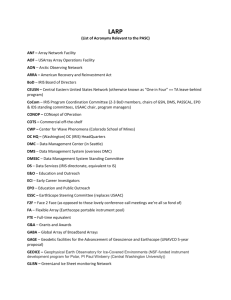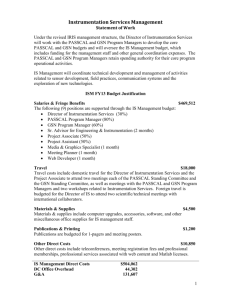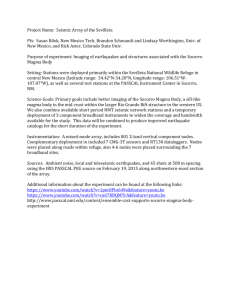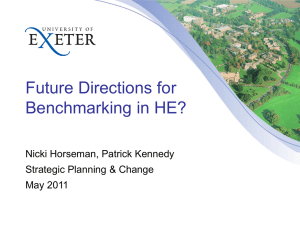Title: IRIS Portable Seismology 2013
advertisement
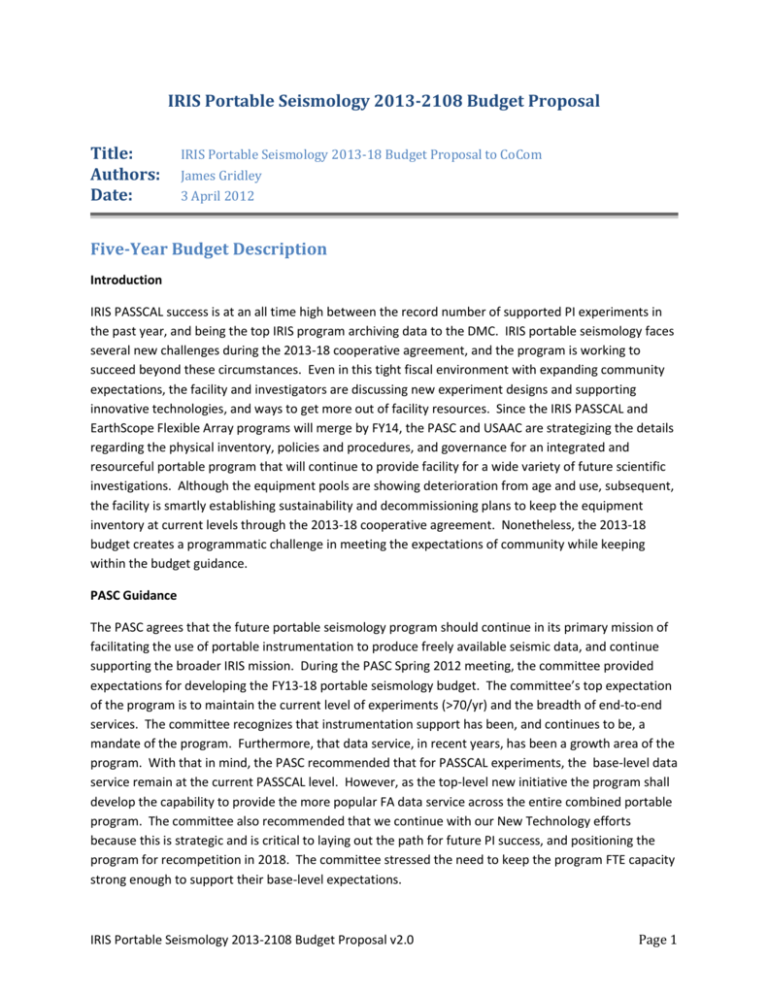
IRIS Portable Seismology 2013-2108 Budget Proposal Title: Authors: Date: IRIS Portable Seismology 2013-18 Budget Proposal to CoCom James Gridley 3 April 2012 Five-Year Budget Description Introduction IRIS PASSCAL success is at an all time high between the record number of supported PI experiments in the past year, and being the top IRIS program archiving data to the DMC. IRIS portable seismology faces several new challenges during the 2013-18 cooperative agreement, and the program is working to succeed beyond these circumstances. Even in this tight fiscal environment with expanding community expectations, the facility and investigators are discussing new experiment designs and supporting innovative technologies, and ways to get more out of facility resources. Since the IRIS PASSCAL and EarthScope Flexible Array programs will merge by FY14, the PASC and USAAC are strategizing the details regarding the physical inventory, policies and procedures, and governance for an integrated and resourceful portable program that will continue to provide facility for a wide variety of future scientific investigations. Although the equipment pools are showing deterioration from age and use, subsequent, the facility is smartly establishing sustainability and decommissioning plans to keep the equipment inventory at current levels through the 2013-18 cooperative agreement. Nonetheless, the 2013-18 budget creates a programmatic challenge in meeting the expectations of community while keeping within the budget guidance. PASC Guidance The PASC agrees that the future portable seismology program should continue in its primary mission of facilitating the use of portable instrumentation to produce freely available seismic data, and continue supporting the broader IRIS mission. During the PASC Spring 2012 meeting, the committee provided expectations for developing the FY13-18 portable seismology budget. The committee’s top expectation of the program is to maintain the current level of experiments (>70/yr) and the breadth of end-to-end services. The committee recognizes that instrumentation support has been, and continues to be, a mandate of the program. Furthermore, that data service, in recent years, has been a growth area of the program. With that in mind, the PASC recommended that for PASSCAL experiments, the base-level data service remain at the current PASSCAL level. However, as the top-level new initiative the program shall develop the capability to provide the more popular FA data service across the entire combined portable program. The committee also recommended that we continue with our New Technology efforts because this is strategic and is critical to laying out the path for future PI success, and positioning the program for recompetition in 2018. The committee stressed the need to keep the program FTE capacity strong enough to support their base-level expectations. IRIS Portable Seismology 2013-2108 Budget Proposal v2.0 Page 1 Budget Description Maintaining the core has been an ongoing direction from the Board of Directors and PASC in the past year. Little resource has gone into purchasing new equipment, specifically sensors, and the program has focused on providing services and strategically planning for the future. The FY13-18 budget plan extends this vision, and for this discussion, we assume a physically integrated FA and PA equipment pools, with reasonable and nonrestrictive policies, so that the facility can maximize PI scheduling and use of equipment. Furthermore, the budget plan assumes continued end-to-end support of experiments, as the PIs have requested in recent years. Therefore, we developed a budget plan based on this continuing theme of maintaining the base-level program, but with the FA and PA inventory merger, and a specific budget target in mind. Merging the PA and FA budgets is not necessarily a simple task. The budgets and FTE are not simply a summation of the two. For example, the PASSCAL budget is well defined however, the FA budget is part of the AOF agreement (TA and FA) and it is not clear how the PIC applied these resources between the programs. Furthermore, PA and FA leverage FTE and people for efficiency. Therefore, a 10% cut in individual budgets, when merged, may result in something other than 10%. Since we based the general budget on extension of the FY13 budgets and WBS, then the WBS, in figure 1, provides a framework in which to describe the FY13-18 budget plan. Figure 1. Graphic description of the work breakdown structure for Portable or PI Facilities. Management Management budget items are primarily program-level related travel, meetings, and conference attendance. This planned budget item is the same as in FY13 with no planned substantial change over the FY13-18 period. Governance The governance element of the budget supports program governance for travel and meetings. Since we do not yet know if the program governance responsibilities will change with the IRIS Portable Seismology 2013-2108 Budget Proposal v2.0 Page 2 merger of the PA and FA pools, I have kept the budget plan at the FY13 level with no planned substantial change over the FY13-18 period, until directed otherwise. Instrumentation Systems Instrumentation systems covers tasks related to instrumentation support. This area includes a modest fund for the program manager to purchase materials and supplies and remains at the FY13 level under the concept of maintaining the core. This also includes a moderate level of system maintenance and repairs. The remaining budgeted money is divided between the UTEP and NMT subawards. This element increases slightly over the FY13-18 period, and within the NMT subaward only. PI Support (Experiment Support) PI support includes FTE in direct support of PI experiments, from logistics to actual in field assistance. The program manager has travel funds, shipping, and most importantly, insurance budgeted at FY13 levels with no substantial change over the FY13-18 period. Furthermore, subaward tasking primarily with NMT, but some with UTEP, covers FTE costs, and only slightly increases over the FY13-18 period, and within the prescribe budget guidance. Data Services The data services budget is primarily for FTE to support this task. A few indirect costs are associated with this task, but at FY13 levels with no substantial change during the FY13-18 period. FTE for this task is in the NMT subaward and is funded specifically to provide PASSCAL level data services only. This task is considered base level and has only a slight increase over the FY13-18 period, and within the prescribe budget guidance. Further Comments on the Subawards The product-based WBS does not completely represent the nature of the facility. Several additional and common tasks are “integrated” or “striped”, across the products. For example, software support is critical to all elements whether it is supporting instrument evaluation, data analysis, or even problems in the field, but with a primary focus on PI needs. In addition, certain general program operations are necessary across the products including basic administrative tasks and personnel supervision. Furthermore, the program supports all sorts of IRIS level projects related to the core mission, these are commonly known as “unfunded mandates” and “unfunded opportunities”. Flexibility in tasking has been important to IRIS PASSCAL success, the PASC noted that services like education, and special projects with PIs and students has greatly enhance the value the program provides. One PASC member was quoted saying that he liked the “yes we can mentality” at the PIC and stressed that this level of flexibility must continue into the next cooperative agreement. IRIS Portable Seismology 2013-2108 Budget Proposal v2.0 Page 3 An additional consideration and complexity for budget planning in the combined programs, has to do with the historic operations at the PIC. The facility, whether supporting PASSCAL, Polar, FA, AOF, and even the TACO, has utilized personnel and expertise across the different programs. For example, the warehouse staff, software developers, and sensor experts apply their time and expertise across the different programs and may be thought of in a budget plan as a single person, but log their time against multiple programs. Previous leadership recognized the efficiency and value in this operational approach, which is now a regular business practice. The issue lies in the complexity of merging, and in another sense dividing, program resources in terms of people and FTE. For example, a person may be applying their time and skills across multiple programs. This would be a partial FTE to the programs, but a total FTE to the facility, in the form a single person. In other words, a person is not necessary tied to a single task on a single program, and if you remove that person, it may affect multiple programs and multiple tasks. Specifically, a software engineer, might also spend time doing field support for the Polar program. Take the software engineer away and we lose the polar support as well. In planning the budget, we have tried to account for as much of the integrated people as we can, but this is only an initial estimate. In its totality, the complexity removes a substantial level of predictability in the expected level of services and number of experiments we may be able to support. New Technologies Effort The new technologies effort was presented to and approved by the PASC and BoD in the spring of 2011. PIF-PA-2012-05 and 06 describe the original proposal. A fundamental theme during FY13-18 is the development of new instrumentation, and consequent demonstration array, to specifically address large N, and quick deployment experiments. This effort is required to support not only new technologies for new instrumentation, but also addressing new field methodologies, such as the direct burial project. The PASC wants to utilize this effort for developing and infusing innovative technologies into the PASSCAL program as core function, which creates capability, predictability, and consistency across the facility and supports PI experiment success. We propose this budget element as an “add on” to the base-line program budget. During FY12, this task took time getting started. Originally, this was suppose to be a separate award, but ended up being a separate task within a single award that included PIC and Polar operations. Furthermore, we plan to fund FY13 from program carryover in FY12. Though we proposed this effort as an ongoing task, so far it has not fully developed into that. Nonetheless, this is critical to the new instrumentation development and we recommend this as an add on task for the FY13-18 period. Statement of Cuts or Efficiencies As suggested above, the program already utilizes an integrated facility approach to make best and efficient use of resources. Reducing budget and FTE levels creates tension in this balance and could cause enough disruption that we provide less end-to-end services, and consequently, force us to move PIs off the schedule to later dates, while reducing the number of experiments per year. On the other hand, we have not fully explored other possibilities such as balancing facility resources with outside contractors for specific tasks such as software support. This has the advantage of more budget control, IRIS Portable Seismology 2013-2108 Budget Proposal v2.0 Page 4 but could make the program less responsive to PI needs, and erode that “yes we can mentality” at the PIC. In developing the budget plan, I applied the PASSCAL program model. I will attempt to unify the combined program level activities, such as travel and materials and supplies, into a single consolidated budget plan at the FY13 PASSCAL budget level. In other words, I will operate the combined PASSCAL and Flexible Array management and governance tasks at the PASSCAL FY13 level until it becomes necessary to do otherwise. The PASC recognized that FA data service, which requires more FTE than the PASSCAL service, has been a growth area for the program. The committee suggested moving the FA data service level into New Initiatives during FY13-18, and that we develop those capabilities with a particular focus on new instrumentation and aspiring to archive ready field data. This strategic change reduces stress on the data service support and normalizes all PI data expectations. This has the added advantage of giving the program time to work with the DMC and develop turnkey field to archive solutions instead of piecewise development. Additionally, important program efficiency lies with our use of student help. The PIC utilizes student help at a less than typical FTE rate. PIC staff has indentified tasks across the WBS where students help from warehouse work, to basic clerical tasks, and even programmers. The benefit of using and managing these students is a serious advantage to the PIC being at New Mexico Tech. Though we could make more use of student help, most remaining tasks are more suited for professionals, or the supervisory burden makes it prohibitive. Utilizing student workers reinforces the notion that the program and facility already sought these program efficiencies in the earlier program development, and seeking further efficiencies becomes a greater challenge. Overhead rates at NMT went up in FY12. The program had to absorb an approximate 23% to 43% increase. In FY12, the program fully realized these new costs while working with a decrease in budget. We managed to cut enough areas of the budget to contain the increase, but as of FY14, the only considerable gain in budget efficiency will be through a reduction in FTE and consequent services. Perhaps the most disturbing aspect of the FY13-18 budget is the unknown effect of the budget reduction on the FTE and resources to the PIs. Depending on how the Transportable Array supports the AOF, we are looking at a reduction in force at the PIC at up to 7 FTE. As a point of reference, the proposed budget translates into a 15-25% loss of FTE, depending on how you count the FTE across the PIC, including potential affects of any TA reductions. This could have serious negative effects to the PIs, the programs and employees. For example, the combined portable program may have to consider not providing in-field support of small experiments (less than 10 systems for example) because these are a less efficient use of FTE resources. We will have to strictly enforce the PI agreement, which will put PIs under more scrutiny to maintain the agreed upon schedule. In addition, we will likely reduce our large experiment surge capacity. This will reduce our capacity to support larger experiments and place greater stress on the equipment use schedule. I am concerned that the program and IRIS may lose its good reputation with the community, which could make it more difficult to garner community support IRIS Portable Seismology 2013-2108 Budget Proposal v2.0 Page 5 and hire staff in the future. The challenge for the program will be how to maintain current levels of community expectations while supporting larger experiments, and strategically positioning itself for recompetition in 2018. These potential FTE numbers suggest the program may not be able to maintain the current level of experiments and the end-to-end services. The community and program may have to face a certain reality and adjust expectations. My best estimate for establishing a programmatic base-level, which is congruent with PASC expectations, is an increase in approximately 5 FTE, or about $750,000 above the proposed base-level. Another way to think of this FTE difference is simply not hiring the current open positions, which is about five. This may require moving a few people around or retooling some skills, but keeps the manpower at FY11 and FY12 levels. Admittedly, this is only estimate, and we do not actually know whether the program will struggle to maintain the FY11/12 experiment and PI support levels. However, given recent stress levels and trends, the simple and obvious answer is that the program will struggle to meet BoD, PASC, and PI expectations. Regarding the new technologies add on, to be blunt, without this support the development of any new instrumentation and demonstration array will not be possible without cutting into the base-level program FTE. If we have to do that, it will come at the cost of experiment support because there is nowhere else to capture the required expertise and resource. Prioritized List of New Initiatives The PASC has recommended the following as prioritized new initiatives: 1. Increase in data services level (PIF-PA-2012-01) 2. Active source initiative (PIF-PA-2012-02) 3. Equipment preparation for Alaska deployments (PIF-PA-2012-03) See the PIFs below for a complete description of the new initiatives. Participation in New Pan-IRIS Initiatives The PASC has prioritized the need for new instrumentation in the FY13-18 period. Furthermore, the committee has recognized that this development is the gateway to new and innovative science, such as “large N” experiments and quick deployments, while creating more efficiency in the facility. The reason we consider this pan IRIS is because the development has applications across program such as GSN’s proposal for Array of Arrays, and possibly areas of the Transportable Array in Alaska. Since we are also looking to streamline data archiving, we require input and coordination with the DMC. For an explanation of the new instrumentation project, see PIF-PA-2012-04. Instrumentation Services As stated above, new sensor development could support the GSN Array of Arrays initiative, and possibly the TA in Alaska. Furthermore, PASSCAL Polar experts are prepared to provide assistance in the TA Alaska effort. The program has considered how to absorb and distribute any surplus equipment as the IRIS Portable Seismology 2013-2108 Budget Proposal v2.0 Page 6 TA completes the continental US deployment. This could benefit GSN, IDS, EPO, and even PASSCAL itself. DMC The program has been, and will continue to, work with the DMC on the Mustang project. This project will benefit the program and PIs, as we develop consistent standards and processes for station deployment methods, and data archiving. Working with the DMC will be critical in any new instrumentation development if we plan to realize a sensor to archive data solution. IDS The PASSCAL program plans to continue supporting IDS though the program mission. In addition, as we consider plans to decommission equipment, we will be working with IDS to create a plan that may support the IDS mission. Limitations on program FTE will prohibit the use of FTE resources to support any significant effort, though we remain open to the possibilities. EPO PASSCAL has been a long-time supporter of the IRIS education mission. The facility hosts the yearly intern orientation at the beginning of the summer program. Beyond that, the program fundamentally teaches new scientists about instrumentation and empirical side of seismology. The program has hosted individuals seeking everything from understanding instrumentation and basic data handling and analysis, to complex engineering solutions related to Polar deployments. Possible and Future Funding Sources The PASC has considered possible funding sources in the abstract for specific projects but has not developed a plan to pursue any as of yet. For example, we discussed the idea of approaching the oil and gas industry for development of new instrumentation, and potential strategies for seeking an MRI. IRIS Portable Seismology 2013-2108 Budget Proposal v2.0 Page 7
